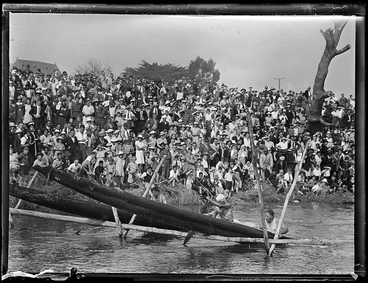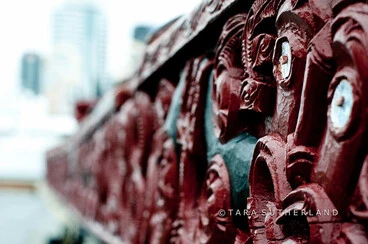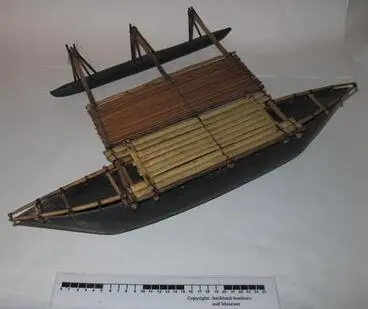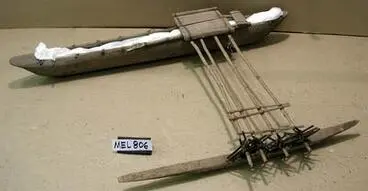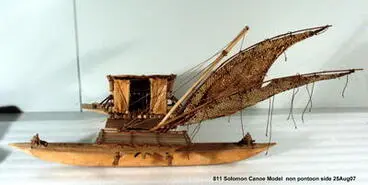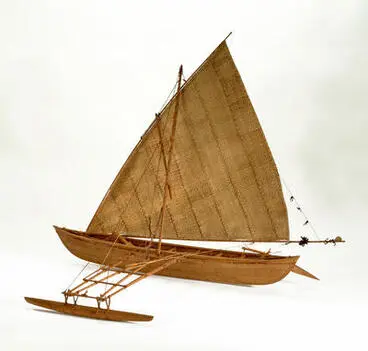Waka Hourua: Tuia Mātauranga Curiosity Card
A DigitalNZ Story by National Library Services to Schools
The waka hourua (double-hulled canoe) Te Aurere being greeted in Tūranganui-a-Kiwa / Poverty Bay — the site of Captain Cook’s first landfall — on 30 December 2009.
WHAKATAUKĪ
"E tū te huru mā, haramai e noho.E tū te huru mangu, hanatū haere."
"While the white hair will stay put, the black hair with set forth on the journey."
Te Aurere
Manatū Taonga, the Ministry for Culture and Heritage
Hekenukumai Busby
Manatū Taonga, the Ministry for Culture and Heritage
Double-hulled canoe, Tonga, 1790s
Manatū Taonga, the Ministry for Culture and Heritage
Tagata Pasifika - Hine Moana: A Journey Home
NZ On Screen
BACKGROUND
Polynesian double-hulled canoes
Polynesians developed the double-hulled canoe (sometimes called a twin-hulled canoe or catamaran) to sail in the rougher waters of the open Pacific. Some of these canoes were very large – one Fijian ndrua measured 36 metres long (Cook's Endeavour was 33 metres). European explorers and missionaries reported ndrua carrying up to 250 people.
Ndrua had two hulls, one slightly longer than the other. The longer main hull could bear the weight of heavy loads; the shorter hull allowed manoeuvrability, functioning in much the same way as an outrigger.
The Tongan adaptation of ndrua was called kalia, and the Samoan equivalent was ‘alia. They were best suited for ferrying large numbers of people on trips between nearby islands.
Source: 'Canoe navigation — Waka — canoes', URL: http://www.teara.govt.nz/en/canoe-navigation/page-1, (Ministry for Culture and Heritage), (published 8-February-2005)
Waka hourua ki Te Moana-nui-a-Kiwa
Ka whakawhanake ngā iwi o Te Moana-nui-a-Kiwa i te waka hourua kia pai ai te rere i ngā moana pukepuke o Te Moananui-a-Kiwa. Inā te nui o ētahi o ēnei tūmomo waka – e 36 mita te roa o tētahi waka ndrua nō Whītī (e 33 mita te roa o Endeavour). E ai ki ngā kaihōpara me ngā mihingare o Ūropi, neke atu ki te e 250 ngā tāngata ka taea i tētahi ndrua o Whītī.
He waka hourua te ndrua, ko tētahi takere he roa ake i tōna hoa. Ko ngā kawenga taumaha ka utaina ki te takere roa; ka rite te mahi a te takere poto ki tō te ama i te waka ama.
Me kī, ko te ndrua ki Whītī, ko te kalia ki Tonga, ko te ‘alia ki Hāmoa. He pai ngā waka nei hei kawe i te nui o te tangata i waenganui i ngā moutere pātata.
Source: 'Te whakatere waka — Waka', URL: http://www.teara.govt.nz/mi/te-whakatere-waka/page-1, (Ministry for Culture and Heritage), (published 8-February-2005)
[Waka drawings]
Alexander Turnbull Library
Waka Warriors - Full Series
NZ On Screen
‘The legend of the voyage to New Zealand’
Manatū Taonga, the Ministry for Culture and Heritage
QUICK FACTS
- Waka hourua are ocean-going canoes that have sails. They are not paddled.
- These waka were built without nails. Instead, waka hourua were lashed together using rope.
- To sail waka hourua, traditional navigation (sometimes called wayfinding) was used.
- Wayfinding involved a deep knowledge of the stars, moon, wave patterns, cloud formation and even birds.
- When Captain Cook first arrived in New Zealand, he reported seeing double-hulled waka. These were mostly sighted in the South Island.
- Sir Peter Blake’s record-breaking catamaran (Steinlager 1) was based on Polynesian designs.
Polynesian double hull
Manatū Taonga, the Ministry for Culture and Heritage
Model wa'a kaulua (sailing canoe from Hawai'i)
Museum of New Zealand Te Papa Tongarewa
Vaka akaraanga
Auckland War Memorial Museum Tāmaki Paenga Hira
canoe, model
Auckland War Memorial Museum Tāmaki Paenga Hira
Model Tipaerua (sailing canoe)
Museum of New Zealand Te Papa Tongarewa
Model Tongiaki (sailing canoe)
Museum of New Zealand Te Papa Tongarewa
OTHER RESOURCES
Kupe – Voyaging by the Stars — a bilingual documentary.
Navigating without instruments — the 2012–2013 voyage of the Waka Tapu confirmed that it is possible to successfully and deliberately travel great distances by canoe while navigating without instruments.
Ocean voyaging — the principles of traditional Polynesian navigation were simple, but its practice was refined with generations of experience.
Polynesian discovery — who were the greatest navigators in history?
Rediscovering traditional Māori navigation — recently, there has been renewed interest in understanding how Polynesian peoples navigated the Pacific.
Te Toki Waka Hourua (video) — Pacific wayfinding on a waka hourua.
Te Toki Waka Hourua — a website dedicated to revitalising and celebrating traditional Pacific voyaging culture.
The Waka Tapu voyage — Jack Thatcher commanded the two waka hourua that sailed from Aotearoa to Rapanui and back.
Waka hourua — the ancient craft that carried the first settlers to New Zealand were probably double-hulled. They are called 'waka hourua'.
Waka hourua Tairawhiti arrives — when waka hourua Tairawhiti arrived at its Gisborne home port on Christmas Eve, a 27-year-old dream had finally been realised.
Waka hourua 'Te Aurere Iti' — Te Aurere-iti is a small (about one-third size) replica of the modern waka hourua (double-hulled voyaging canoe) Te Aurere.
Waka landing places — waka landing sites in Aotearoa.
Waka revival — waka is the Māori word for canoe. Māori ancestors were great canoe builders, navigators and sailors.
Welcoming Haunui — Haunui is one of seven waka hourua that crossed the Pacific in 2011 as part of the Te Mana o Te Moana voyage.
Te Aurere waka hourua — double hulled voyaging canoe — he waka hourua i hangaia e Hekenukumai Busby.
Te Matau a Māui — he waka hourua e mahi ana hei rauemi whakaako tikanga whakatere waka i Ahuriri.
World-famous waka
Manatū Taonga, the Ministry for Culture and Heritage
[Maori waka on Auckland Harbour]
Auckland War Memorial Museum Tāmaki Paenga Hira
Canoes - waka, Ngaruawahia regatta?
Auckland Libraries
Waka
Manatū Taonga, the Ministry for Culture and Heritage
Anchor stone from the waka Matahorua
Alexander Turnbull Library
Samoan war canoe
Alexander Turnbull Library
FERTILE QUESTIONS
- How and why do people explore?
- He aha te take me pupuri tonu tātou ki ngā tikanga whakatere waka?
- Why and how did different peoples cross the Pacific Ocean?
- What is the impact of human migration on a place?
- What is your question?
Paddles obtained on Cook's first voyage
Manatū Taonga, the Ministry for Culture and Heritage
Canoe bailer
Museum of New Zealand Te Papa Tongarewa
Anchor stone
Museum of New Zealand Te Papa Tongarewa
Rock drawing
Manatū Taonga, the Ministry for Culture and Heritage
Pacific voyaging
Manatū Taonga, the Ministry for Culture and Heritage
Strutt, William, 1825-1915 :Maori girls shooting the waves. N. Zealand. [1855 or 1856]
Alexander Turnbull Library
ADDITIONAL QUESTIONS
- Why is it important to maintain traditional knowledge?
canoe, model
Auckland War Memorial Museum Tāmaki Paenga Hira
Canoe model
Auckland War Memorial Museum Tāmaki Paenga Hira
canoe model
Auckland War Memorial Museum Tāmaki Paenga Hira
canoe, model
Auckland War Memorial Museum Tāmaki Paenga Hira
Model canoe
Museum of New Zealand Te Papa Tongarewa
This story was curated and compiled by Te Puna Mātauranga o Aotearoa | National Library of New Zealand, Services to Schools staff, 2019.



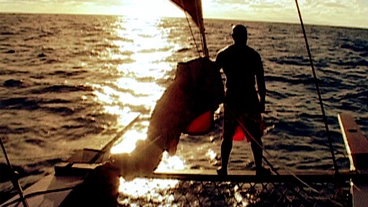



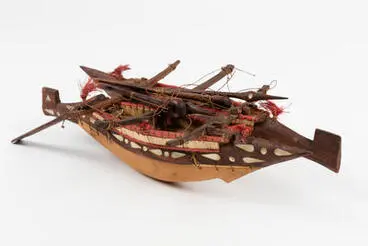
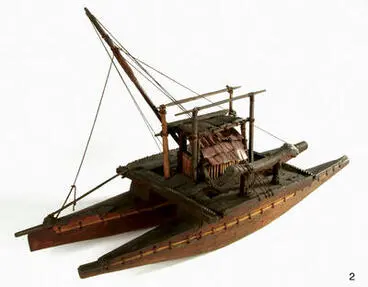

![[Maori waka on Auckland Harbour] Image: [Maori waka on Auckland Harbour]](https://thumbnailer.digitalnz.org/?resize=770x&src=https%3A%2F%2Fcollection-api.aucklandmuseum.com%2Frecords%2Fimages%2Fmedium%2F665060%2F4fc828183b855575ad0214ac711b2dd4afd02990.jpg&resize=368%253E)
